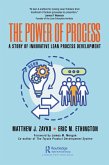

Alle Infos zum eBook verschenken

- Format: PDF
- Merkliste
- Auf die Merkliste
- Bewerten Bewerten
- Teilen
- Produkt teilen
- Produkterinnerung
- Produkterinnerung

Hier können Sie sich einloggen

Bitte loggen Sie sich zunächst in Ihr Kundenkonto ein oder registrieren Sie sich bei bücher.de, um das eBook-Abo tolino select nutzen zu können.
Drawing on knowledge from process improvement, organisation theory, human resource management, change management, occupational health and safety, and other fields, the book is a practical, easy-to-read guide to problem solving.
Illustrated with a series of short case studies, this book provides an integrated approach to problem solving in the workplace. Collaborative Problem Solving walks through the steps in the problem solving process, introducing dozens of tools, techniques, and concepts to use throughout. Chris J. Shannon describes the behaviours to practice which are most conducive to…mehr
- Geräte: PC
- mit Kopierschutz
- eBook Hilfe
![Collaborative Problem Solving (eBook, ePUB) Collaborative Problem Solving (eBook, ePUB)]() Chris J. ShannonCollaborative Problem Solving (eBook, ePUB)33,95 €
Chris J. ShannonCollaborative Problem Solving (eBook, ePUB)33,95 €![Creative Problem Solving for Managers (eBook, PDF) Creative Problem Solving for Managers (eBook, PDF)]() Tony ProctorCreative Problem Solving for Managers (eBook, PDF)42,95 €
Tony ProctorCreative Problem Solving for Managers (eBook, PDF)42,95 €![Absolute Essentials of Creative Thinking and Problem Solving (eBook, PDF) Absolute Essentials of Creative Thinking and Problem Solving (eBook, PDF)]() Tony ProctorAbsolute Essentials of Creative Thinking and Problem Solving (eBook, PDF)19,95 €
Tony ProctorAbsolute Essentials of Creative Thinking and Problem Solving (eBook, PDF)19,95 €![The Power of Process (eBook, PDF) The Power of Process (eBook, PDF)]() Matthew ZaykoThe Power of Process (eBook, PDF)33,95 €
Matthew ZaykoThe Power of Process (eBook, PDF)33,95 €![Innovation Sucks! (eBook, PDF) Innovation Sucks! (eBook, PDF)]() Alan WatkinsInnovation Sucks! (eBook, PDF)32,95 €
Alan WatkinsInnovation Sucks! (eBook, PDF)32,95 €![Creative Leadership (eBook, PDF) Creative Leadership (eBook, PDF)]() Creative Leadership (eBook, PDF)43,95 €
Creative Leadership (eBook, PDF)43,95 €![Quality Service Management (eBook, PDF) Quality Service Management (eBook, PDF)]() John MaleyeffQuality Service Management (eBook, PDF)33,95 €
John MaleyeffQuality Service Management (eBook, PDF)33,95 €-
-
-
Illustrated with a series of short case studies, this book provides an integrated approach to problem solving in the workplace. Collaborative Problem Solving walks through the steps in the problem solving process, introducing dozens of tools, techniques, and concepts to use throughout. Chris J. Shannon describes the behaviours to practice which are most conducive to creating a positive problem solving culture based on curiosity, collaboration, and evidence-based thinking. This book explains why successful problem solving is a collaborative process and provides tools and techniques for responding to other people's behaviour when designing and implementing solutions.
Offering practical advice on problem solving in an easy-to-understand way, this book is aimed at people working in office environments, service industries, and knowledge organisations, enabling them to feel confident in applying the knowledge from the book in their own workplace.
Dieser Download kann aus rechtlichen Gründen nur mit Rechnungsadresse in A, B, BG, CY, CZ, D, DK, EW, E, FIN, F, GR, HR, H, IRL, I, LT, L, LR, M, NL, PL, P, R, S, SLO, SK ausgeliefert werden.
- Produktdetails
- Verlag: Taylor & Francis eBooks
- Seitenzahl: 170
- Erscheinungstermin: 22. Juni 2021
- Englisch
- ISBN-13: 9781000389425
- Artikelnr.: 61693830
- Verlag: Taylor & Francis eBooks
- Seitenzahl: 170
- Erscheinungstermin: 22. Juni 2021
- Englisch
- ISBN-13: 9781000389425
- Artikelnr.: 61693830
- Herstellerkennzeichnung Die Herstellerinformationen sind derzeit nicht verfügbar.
Introduction
I.1 Problems and opportunities
I.2 Do what you can from where you are
I.3 Solving and sharing
I.4 How to use this book
Chapter 1 The Problem Solving Model
1.1 Problem solving overview
1.1.1 Similar features
1.2 Steps in the problem solving process
1.3 Problem solving behaviours
1.4 Problem solving tools
1.5 Creating shared understanding
Chapter 2 Problem Solving Behaviour
2.1 Curiosity
2.1.1 Curiosity through sharing
2.2 Collaboration
2.3 Evidence-based thinking
2.3.1 Current state data
2.3.2 Future state data
2.4 Leadership and problem solving
2.5 Contemporary Leadership Theories
2.5.1 Transformational leadership
2.5.2 Exemplary leadership
2.5.3 Servant leadership
2.5.4 Lean leadership
Chapter 3 Perceiving the Problem
3.1 Is there actually a problem to solve?
3.2 AIR 1 (Assessing Initial Readiness)
3.3 FOG (Fact, Opinion, Guess)
3.4 Five whys
3.5 User stories
3.6 Purposeful conversations
3.6.1 Standing up for desks
3.7 Consensus building
Chapter 4 Defining the Problem
4.1 What is the problem we are trying to solve?
4.2 High level process map
4.2.1 Networked business
4.3 Scoping document
4.4 In frame / out of frame
4.5 Problem solving teams
4.5.1 The iceberg of ignorance
4.5.2 Ordering new bins
4.6 Fishbone diagram
4.7 A3 problem statement
4.8 AIR 2 (Alignment, Impact Readiness)
4.9 Measures to consider
4.9.1 Is checking necessary?
4.9.2 Error reduction measures
4.9.3 Behavioural or cultural change
Chapter 5 Investigating the Problem
5.1 Do we fully understand the problem?
5.2 Understanding a process
5.3 Swim lane process map
5.4 Value vs non-value adding steps
5.4.1 The welcome back event
5.5 Rapid improvement event
5.5.1 Virtual RIE in Tasmania
5.6 Case study: Improving the onboarding process (Part 1)
5.7 Four voices
5.8 Eight wastes
5.9 RRS (runners, repeaters, strangers)
5.10 Theory of constraints
5.11 Case study: Improving the onboarding process (Part 2)
5.12 Case study: The new payroll system
5.12.1 Fishbone diagram
5.12.2 Pareto analysis
5.12.3 A3 problem statement
5.13 Stakeholder analysis
5.14 Spaghetti diagram
Chapter 6 Selecting the Solution
6.1 Are we confident we have picked the best solution?
6.2 Ease/benefit analysis
6.2.1 Determining ease
6.2.2 Determining benefit
6.3 Designing out errors (Poka yoke)
6.3.1 Cars and phones
6.4 Repeatable and Reproducible
6.5 Reducing cost vs creating capacity
6.5.1 Discretionary effort
6.6 SMART Goals
6.7 Interim solutions vs future state solutions
Chapter 7 Implementing the Solution
7.1 Are we ready to solve the problem?
7.2 Implementation action list
7.3 RACI chart
7.4 Visual management
7.5 Seeing new behaviour emerge
7.6 Automation makes problems visible
7.6.1 The visibility paradox
7.6.2 Helping the customer accept and adopt
7.6.3 Desire paths
Chapter 8 Reviewing the Results
8.1 Have we solved the problem?
8.2 Reviewing performance
8.3 Track your capacity creation
8.4 Customer journey maps
8.5 STAR story telling
8.6 Visual displays
8.7 Process heat maps
8.8 Reflection on the problem solving process
Chapter 9 Responding to Other People's Behaviour
9.1 Types of conflict
9.1.1 Intrapersonal conflict
9.1.2 Interpersonal conflict
9.1.3 Role conflict
9.1.4 Intragroup conflict
9.2 Hierarchy of needs
9.3 Group dynamics
9.4 Two factor theory
9.5 Force field analysis
9.6 Supporting purposeful conversations
9.7 Interest Based Negotiation
9.8 Practicing Responses
Conclusion
Index
Introduction
I.1 Problems and opportunities
I.2 Do what you can from where you are
I.3 Solving and sharing
I.4 How to use this book
Chapter 1 The Problem Solving Model
1.1 Problem solving overview
1.1.1 Similar features
1.2 Steps in the problem solving process
1.3 Problem solving behaviours
1.4 Problem solving tools
1.5 Creating shared understanding
Chapter 2 Problem Solving Behaviour
2.1 Curiosity
2.1.1 Curiosity through sharing
2.2 Collaboration
2.3 Evidence-based thinking
2.3.1 Current state data
2.3.2 Future state data
2.4 Leadership and problem solving
2.5 Contemporary Leadership Theories
2.5.1 Transformational leadership
2.5.2 Exemplary leadership
2.5.3 Servant leadership
2.5.4 Lean leadership
Chapter 3 Perceiving the Problem
3.1 Is there actually a problem to solve?
3.2 AIR 1 (Assessing Initial Readiness)
3.3 FOG (Fact, Opinion, Guess)
3.4 Five whys
3.5 User stories
3.6 Purposeful conversations
3.6.1 Standing up for desks
3.7 Consensus building
Chapter 4 Defining the Problem
4.1 What is the problem we are trying to solve?
4.2 High level process map
4.2.1 Networked business
4.3 Scoping document
4.4 In frame / out of frame
4.5 Problem solving teams
4.5.1 The iceberg of ignorance
4.5.2 Ordering new bins
4.6 Fishbone diagram
4.7 A3 problem statement
4.8 AIR 2 (Alignment, Impact Readiness)
4.9 Measures to consider
4.9.1 Is checking necessary?
4.9.2 Error reduction measures
4.9.3 Behavioural or cultural change
Chapter 5 Investigating the Problem
5.1 Do we fully understand the problem?
5.2 Understanding a process
5.3 Swim lane process map
5.4 Value vs non-value adding steps
5.4.1 The welcome back event
5.5 Rapid improvement event
5.5.1 Virtual RIE in Tasmania
5.6 Case study: Improving the onboarding process (Part 1)
5.7 Four voices
5.8 Eight wastes
5.9 RRS (runners, repeaters, strangers)
5.10 Theory of constraints
5.11 Case study: Improving the onboarding process (Part 2)
5.12 Case study: The new payroll system
5.12.1 Fishbone diagram
5.12.2 Pareto analysis
5.12.3 A3 problem statement
5.13 Stakeholder analysis
5.14 Spaghetti diagram
Chapter 6 Selecting the Solution
6.1 Are we confident we have picked the best solution?
6.2 Ease/benefit analysis
6.2.1 Determining ease
6.2.2 Determining benefit
6.3 Designing out errors (Poka yoke)
6.3.1 Cars and phones
6.4 Repeatable and Reproducible
6.5 Reducing cost vs creating capacity
6.5.1 Discretionary effort
6.6 SMART Goals
6.7 Interim solutions vs future state solutions
Chapter 7 Implementing the Solution
7.1 Are we ready to solve the problem?
7.2 Implementation action list
7.3 RACI chart
7.4 Visual management
7.5 Seeing new behaviour emerge
7.6 Automation makes problems visible
7.6.1 The visibility paradox
7.6.2 Helping the customer accept and adopt
7.6.3 Desire paths
Chapter 8 Reviewing the Results
8.1 Have we solved the problem?
8.2 Reviewing performance
8.3 Track your capacity creation
8.4 Customer journey maps
8.5 STAR story telling
8.6 Visual displays
8.7 Process heat maps
8.8 Reflection on the problem solving process
Chapter 9 Responding to Other People's Behaviour
9.1 Types of conflict
9.1.1 Intrapersonal conflict
9.1.2 Interpersonal conflict
9.1.3 Role conflict
9.1.4 Intragroup conflict
9.2 Hierarchy of needs
9.3 Group dynamics
9.4 Two factor theory
9.5 Force field analysis
9.6 Supporting purposeful conversations
9.7 Interest Based Negotiation
9.8 Practicing Responses
Conclusion
Index







